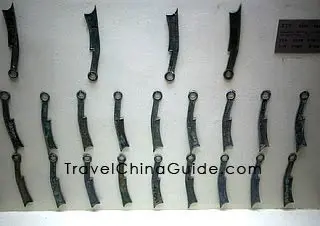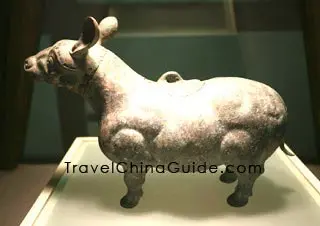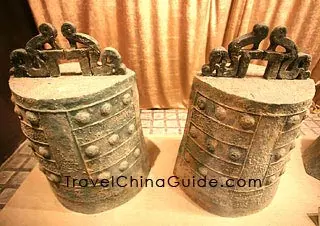Shandong Provincial Museum
 |
| Knife-shaped Coins |
The original museum built in 1954 closed and has been replaced by the new one on a large square in Jingshi Road, east of Yanshan Overpass. This was opened to the public on November 16, 2010. The new five-storey Shandong Provincial Museum has fifteen exhibitions halls where eleven permanent displays are on show. These include figure paintings from the Han Dynasty (202BC - 220AD), Buddhist sculpture, Shandong history and culture and a Confucian Culture exhibition. There is also a collection of calligraphy and paintings, Lu embroidery, fine porcelain articles, etc.
After a security check, visitors follow the sign to enter the 3,000-square-meter (3,600 square yards) main lobby supported with eighteen big pillars. The dominant hue of the lobby is yellow, symbolizing the Yellow River which gave birth to the culture of Shandong and entire China.
Shandong History and Culture Display Area
In addition, for the first time there is a display of all the things unearthed from Zhu Tan (known also as Prince Lu, the 10th son of the first emperor of the Ming Dynasty (1368 - 1644AD) – Zhu Yuanzhang). A batch of precious cultural relics is also on show for the first time. This includes a standing Bodhisattva sculpture with a crown of cicada decoration and mural painting from Dongping Han Dynasty Tombs. The Bodhisattva sculpture was created 1,500 years ago, and now restored to China having been lost to overseas collections for fourteen years.
|
|
Confucius Culture Exhibition
New techniques are employed to give a much more impressive experience for visitors. A visit to Shandong Provincial Museum is like a dialogue with history, revealing the wonders of Shandong.
Note on Qi and Lu Culture
During the Spring and Autumn Period, Confucianism came into being in the Lu State which was located east of Lu and adjacent to the ocean, where industry and commerce developed rapidly. Qi, close to the East China Sea, represents an open atmosphere, while Lu, close to Mt. Taishan, shows relative conservatism promoting farming. Later in the Warring States Period, Mencius (the Lesser Sage as distinguished from Confucius the Sage) in Lu traveled to Qi twice for education and cultural exchange, and the fusion of the Qi and Lu cultures began.
How to get to Shandong Provincial Museum
Jinan Bus Search
| Entrance Fee | Free but visitors need to take their passports to get the tickets. |
|---|---|
| Opening Hours | 09:00-17:00 (closed on Mondays); No admission after 16:00. |
- Last updated on Aug. 13, 2025 by Demi Li -

